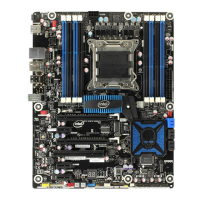Product Description
17
1.4.1 PCI Express x16 Graphics
Intel Core i7 and Intel Xeon processors in an LGA2011 package support PCI Express
add-in graphics cards via the board’s PCI Express x16 connectors. These processors
support the following generations of PCI Express:
• PCI Express 3.0 with a raw bit rate of 8.0 GT/s results in an effective bandwidth of
8.0 Gb/s each direction per lane. The maximum theoretical bandwidth of the x16
interface is 16 GB/s in each direction, simultaneously, for a bandwidth of 32 GB/s.
• PCI Express 2.x with a raw bit rate of 5.0 GT/s results in an effective bandwidth of
4.0 Gb/s each direction per lane. The maximum theoretical bandwidth of the x16
interface is 8 GB/s in each direction, simultaneously, for a bandwidth of 16 GB/s.
• PCI Express 1.x with a raw bit rate of 2.5 GT/s results in an effective bandwidth of
2.0 Gb/s each direction per lane. The maximum theoretical bandwidth of the x16
interface is 4 GB/s in each direction, simultaneously, for a bandwidth of 8 GB/s.
For information about Refer to
PCI Express technology http://www.pcisig.com
1.5 System Memory
The board has eight DIMM sockets and supports the following memory features:
• 1.35 V DDR3 SDRAM DIMMs (JEDEC Specification)
• Four independent memory channels with interleaved mode support
• Unbuffered, single-sided or double-sided DIMMs with the following restriction:
Double-sided DIMMs with x16 organization are not supported.
• 64 GB maximum total system memory (using 4 Gb memory technology). Refer to
Section 2.1.1 on page 41 for information on the total amount of addressable
memory.
• Minimum total system memory: 1 GB using 512 MB x16 module
• Non-ECC and ECC DIMMs
• Serial Presence Detect
• DDR3 2400 MHz, 2133 MHz, 1866 MHz, 1600 MHz, 1333 MHz, and 1066 MHz
SDRAM DIMMs
• XMP performance profile support for memory speeds above 1600 MHz
• Full support for over clocking memory (see
www.intel.com/support/motherboards/desktop/sb/CS-031689.htm for more
information about over clocking)
• DIMM slots are numbered in installation order
NOTE
To be fully compliant with all applicable DDR SDRAM memory specifications, the board
should be populated with DIMMs that support the Serial Presence Detect (SPD) data
structure. This allows the BIOS to read the SPD data and program the chipset to
accurately configure memory settings for optimum performance.

